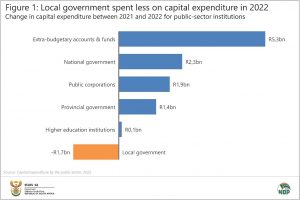Public-sector capital expenditure increases in 2022
After five consecutive years of decline, capital expenditure in the public sector increased by R9,3 billion (4,6%), from R199,8 billion in 2021 to R209,1 billion in 2022. Extra-budgetary accounts and funds, national government, public corporations, provincial government and higher education institutions all recorded increases. However, there was a decline for local government, according to Stats SA’s Capital expenditure by the public sector statistical release (Figure 1).

A major reason for the overall increase was the suspension of COVID-19 lockdown restrictions in 2021. This allowed for the resumption of construction projects and acquisition of capital assets.
Capital expenditure represents money that is spent on new construction works; plant, machinery and equipment; land and existing buildings; leased assets and investment property; transport equipment; and other fixed assets.
In 2022, the biggest capital spenders were public corporations, followed by local government, provincial government, and extra-budgetary accounts and funds. National government and higher education institutions spent the least. Below are key highlights from each of these spheres of government.
Public corporations
Public corporations incurred R74,4 billion (35,6% of total public-sector capital expenditure) in 2022. Eskom was a major contributor, accounting for R34,1 billion. Most of this was allocated to Medupi and Kusile power stations, as part of the generation recovery plan.
Transnet Limited was the second biggest spender (R14,5 billion). Capital expenditure was mainly focused on projects at the ports of Durban, Ngqura, Port Elizabeth and Cape Town. Telkom incurred R7,5 billion in 2022. Key initiatives included the deployment of fibre and the next-generation Packet Optical Transport Network (POTN). The Passenger Rail Agency of South Africa recorded capital expenditure of R6,2 billion, with the rolling stock fleet renewal programme accounting for R4,8 billion.
Local government
Although municipalities recorded an overall decline between 2021 and 2022, they accounted for 27,0% (R56,4 billion) of total public-sector capital expenditure in 2022.
As expected, the metropolitan municipalities were the most significant contributors. The City of Johannesburg, for example, spent R6,5 billion on various projects, including the construction of 349 housing units in Roodepoort. The City of Cape Town (R5,7 billion) concentrated on the replacement of water and sewerage mains, as well as the repair of the Bikini Beach seawall. eThekwini (R3,9 billion) focussed mainly on projects related to water mains, beach improvements and the construction of libraries.
Provincial government
Provincial government departments incurred R33,7 billion, representing 16,1% of total public-sector capital expenditure in 2022. The KwaZulu-Natal Department of Transport accounted for R4,0 billion. One of the major projects involved the upgrading of 19 km of road surface to tar and concrete.
The KwaZulu-Natal Department of Education contributed R2,2 billion.
In Western Cape, the Department of Transport and Public Works spent R2,8 billion, mainly on 22 capital road projects in the province.
Extra-budgetary accounts and funds (EBAs)
EBAs accounted for R20,6 billion (9,9%) of public-sector capital expenditure in 2022. The South African National Roads Agency was a heavyweight (R6,9 billion), with upgrades to the N4 national highway a primary project. The Property Management Trading Entity (R3,0 billion) focussed a portion of its capital expenditure on the construction of a magistrate court in Mamelodi. The Water Trading Entity accounted for R2,7 billion. One of its projects involved construction work on phase two of the Lesotho Highlands Water Project.
National government
National government departments accounted for R15,0 billion (7,2%) of public-sector capital expenditure. The South African Police Service (R2,7 billion) focussed its attention on a number of projects, including the construction of two police stations in North West. Capital expenditure by the Department of Water and Sanitation (R2,6 billion) included work on 128 regional bulk infrastructure project phases. The Department of Basic Education initiated construction projects at schools, contributing to a total of R2,1 billion.
Higher education institutions
South Africa’s 26 higher education institutions spent R8,9 billion on fixed assets, accounting for 4,3% of total public-sector capital expenditure. Stellenbosch University spent the most (R0,8 billion), mainly on the new Biomedical Research Institute (BMRI) building. Two key expenditure items from the University of the Witwatersrand (R0,6 billion) included construction work on teaching and administrative buildings, as well as the acquisition of motor vehicles. North-West University (R0,5 billion) upgraded a large housing complex and IT infrastructure.
For more information, download the latest Capital expenditure by the public sector statistical release and Excel files here.
Similar articles are available on the Stats SA website and can be accessed here.
For a monthly overview of economic indicators and infographics, catch the latest edition of the Stats Biz newsletter here.

